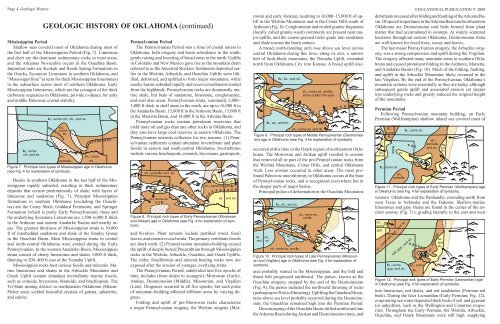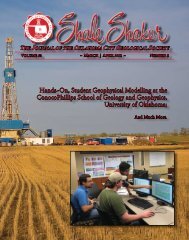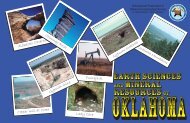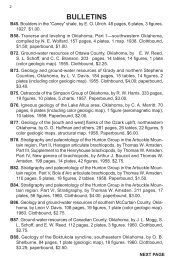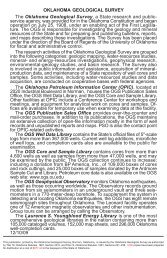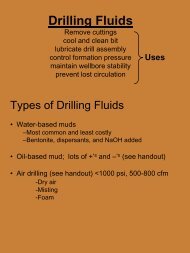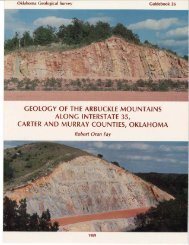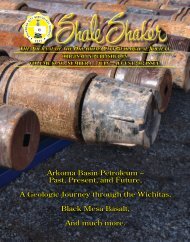Inside pages without cover - Oklahoma Geological Survey
Inside pages without cover - Oklahoma Geological Survey
Inside pages without cover - Oklahoma Geological Survey
Create successful ePaper yourself
Turn your PDF publications into a flip-book with our unique Google optimized e-Paper software.
Page 4, Geologic History<br />
GEOLOGIC HISTORY OF OKLAHOMA (continued)<br />
Mississippian Period<br />
Shallow seas <strong>cover</strong>ed most of <strong>Oklahoma</strong> during most of<br />
the first half of the Mississippian Period (Fig. 7). Limestone<br />
and chert are the dominant sedimentary rocks in most areas,<br />
and the Arkansas Novaculite occurs in the Ouachita Basin.<br />
Important units are Keokuk and Reeds Spring Formations in<br />
the Ozarks, Sycamore Limestone in southern <strong>Oklahoma</strong>, and<br />
“Mississippi lime” (a term for thick Mississippian limestones)<br />
in the subsurface across most of northern <strong>Oklahoma</strong>. Early<br />
Mississippian limestones, which are the youngest of the thick<br />
carbonate sequences in <strong>Oklahoma</strong>, provide evidence for early<br />
and middle Paleozoic crustal stability.<br />
X X<br />
X<br />
X<br />
X<br />
X<br />
X<br />
X<br />
X X XXX XX XX<br />
X<br />
X<br />
Figure 7. Principal rock types of Mississippian age in <strong>Oklahoma</strong><br />
(see Fig. 4 for explanation of symbols).<br />
Basins in southern <strong>Oklahoma</strong> in the last half of the Mississippian<br />
rapidly subsided, resulting in thick sedimentary<br />
deposits that consist predominantly of shale, with layers of<br />
limestone and sandstone (Fig. 7). Principal Mississippian<br />
formations in southern <strong>Oklahoma</strong> (excluding the Ouachitas)<br />
are the Caney Shale, Goddard Formation, and Springer<br />
Formation (which is partly Early Pennsylvanian): these and<br />
the underlying Sycamore Limestone are 1,500–6,000 ft thick<br />
in the Ardmore and eastern Anadarko Basins and nearby areas.<br />
The greatest thickness of Mississippian strata is 10,000<br />
ft of interbedded sandstone and shale of the Stanley Group<br />
in the Ouachita Basin. Most Mississippian strata in central<br />
and north-central <strong>Oklahoma</strong> were eroded during the Early<br />
Pennsylvanian. In the western Anadarko Basin, Mississippian<br />
strata consist of cherty limestones and shales 3,000 ft thick,<br />
thinning to 200–400 ft east of the Nemaha Uplift.<br />
Mississippian rocks host various fossils and minerals. Marine<br />
limestones and shales in the Arbuckle Mountains and<br />
Ozark Uplift contain abundant invertebrate marine fossils,<br />
such as crinoids, bryozoans, blastoids, and brachiopods. The<br />
Tri-State mining district in northeastern <strong>Oklahoma</strong> (Miami-<br />
Picher area) yielded beautiful crystals of galena, sphalerite,<br />
and calcite.<br />
Pennsylvanian Period<br />
The Pennsylvanian Period was a time of crustal unrest in<br />
<strong>Oklahoma</strong>: both orogeny and basin subsidence in the south;<br />
gentle raising and lowering of broad areas in the north. Uplifts<br />
in Colorado and New Mexico gave rise to the mountain chain<br />
referred to as the Ancestral Rockies. Sediments deposited earlier<br />
in the Wichita, Arbuckle, and Ouachita Uplifts were lithified,<br />
deformed, and uplifted to form major mountains, while<br />
nearby basins subsided rapidly and received sediments eroded<br />
from the highlands. Pennsylvanian rocks are dominantly marine<br />
shale, but beds of sandstone, limestone, conglomerate,<br />
and coal also occur. Pennsylvanian strata, commonly 2,000–<br />
5,000 ft thick in shelf areas in the north, are up to 16,000 ft in<br />
the Anadarko Basin, 15,000 ft in the Ardmore Basin, 13,000 ft<br />
in the Marietta Basin, and 18,000 ft in the Arkoma Basin.<br />
Pennsylvanian rocks contain petroleum reservoirs that<br />
yield more oil and gas than any other rocks in <strong>Oklahoma</strong>, and<br />
they also have large coal reserves in eastern <strong>Oklahoma</strong>. The<br />
Pennsylvanian interests collectors for two reasons. (1) Pennsylvanian<br />
sediments contain abundant invertebrate and plant<br />
fossils in eastern and south-central <strong>Oklahoma</strong>. Invertebrates<br />
include various brachiopods, crinoids, bryozoans, gastropods,<br />
X X X X<br />
X<br />
X<br />
X<br />
X<br />
X<br />
X<br />
X<br />
X X X X X X<br />
X<br />
Figure 8. Principal rock types of Early Pennsylvanian (Morrowan<br />
and Atokan) age in <strong>Oklahoma</strong> (see Fig. 4 for explanation of symbols).<br />
X<br />
X<br />
and bivalves. Plant remains include petrified wood, fossil<br />
leaves, and extensive coal strata. The primary vertebrate fossils<br />
are shark teeth. (2) Pennsylvanian mountain-building caused<br />
the uplift of deeply buried Precambrian through Mississippian<br />
rocks in the Wichita, Arbuckle, Ouachita, and Ozark Uplifts.<br />
The older, fossiliferous and mineral-bearing rocks now are<br />
exposed after the erosion of younger, overlying strata.<br />
The Pennsylvanian Period, subdivided into five epochs of<br />
time, includes (from oldest to youngest): Morrowan (Early),<br />
Atokan, Desmoinesian (Middle), Missourian, and Virgilian<br />
(Late). Orogenies occurred in all five epochs, but each pulse<br />
of mountain building affected different areas by varying degrees.<br />
Folding and uplift of pre-Morrowan rocks characterize<br />
a major Pennsylvanian orogeny, the Wichita orogeny (Morrowan<br />
and early Atokan), resulting in 10,000–15,000 ft of uplift<br />
in the Wichita Mountains and in the Criner Hills south of<br />
Ardmore (Fig. 8). Conglomerate and eroded granite fragments<br />
(locally called granite wash) commonly are present near major<br />
uplifts, and the coarse-grained rocks grade into sandstone<br />
and shale toward the basin centers.<br />
A broad, north-trending arch rose above sea level across<br />
central <strong>Oklahoma</strong> during this time; along its axis, a narrow<br />
belt of fault-block mountains, the Nemaha Uplift, extended<br />
north from <strong>Oklahoma</strong> City into Kansas. A broad uplift also<br />
X X X X X X X<br />
X<br />
X X<br />
X<br />
X<br />
X X X X X X<br />
X<br />
Figure 9. Principal rock types of Middle Pennsylvanian (Desmoinesian)<br />
age in <strong>Oklahoma</strong> (see Fig. 4 for explanation of symbols).<br />
occurred at this time in the Ozark region of northeastern <strong>Oklahoma</strong>.<br />
The Morrowan and Atokan uplift resulted in erosion<br />
that removed all or part of the pre-Pennsylvanian rocks from<br />
the Wichita Mountains, Criner Hills, and central <strong>Oklahoma</strong><br />
Arch. Less erosion occurred in other areas. The most profound<br />
Paleozoic unconformity in <strong>Oklahoma</strong> occurs at the base<br />
of Pennsylvanian rocks, and is recognized everywhere but in<br />
the deeper parts of major basins.<br />
Principal pulses of deformation in the Ouachita Mountains<br />
X X X<br />
X<br />
X<br />
X<br />
X<br />
X<br />
X<br />
Figure 10. Principal rock types of Late Pennsylvanian (Missourian<br />
and Virgilian) age in <strong>Oklahoma</strong> (see Fig. 4 for explanation of<br />
symbols).<br />
area probably started in the Mississippian, and the fold and<br />
thrust belt progressed northward. The pulses, known as the<br />
Ouachita orogeny, stopped by the end of the Desmoinesian<br />
(Fig. 9); the pulses included the northward thrusting of rocks<br />
(perhaps up to 50 mi of thrusting). Uplifting the Ouachita Mountains<br />
above sea level probably occurred during the Desmoinesian;<br />
the Ouachitas remained high into the Permian Period.<br />
Downwarping of the Ouachita Basin shifted northward into<br />
the Arkoma Basin during Atokan and Desmoinesian times, and<br />
deformation ceased after folding and faulting of the Arkoma Basin.<br />
Of special importance in the Arkoma Basin and northeastern<br />
<strong>Oklahoma</strong> are Desmoinesian coal beds formed from plant<br />
matter that had accumulated in swamps. At widely scattered<br />
locations throughout eastern <strong>Oklahoma</strong>, Desmoinesian strata<br />
are well known for fossil trees, wood, and leaves.<br />
The last major Pennsylvanian orogeny, the Arbuckle orogeny,<br />
was a strong compression and uplift during the Virgilian.<br />
The orogeny affected many mountain areas in southern <strong>Oklahoma</strong><br />
and caused prominent folding in the Ardmore, Marietta,<br />
and Anadarko Basins (Fig. 10). Much of the folding, faulting,<br />
and uplift in the Arbuckle Mountains likely occurred in the<br />
late Virgilian. By the end of the Pennsylvanian, <strong>Oklahoma</strong>’s<br />
mountain systems were essentially as they are today, although<br />
subsequent gentle uplift and associated erosion cut deeper<br />
into underlying rocks and greatly reduced the original height<br />
of the mountains.<br />
Permian Period<br />
Following Pennsylvanian mountain building, an Early<br />
Permian (Wolfcampian) shallow inland sea <strong>cover</strong>ed most of<br />
X XX<br />
X X X<br />
EDUCATIONAL PUBLICATION 9: 2008<br />
Figure 11. Principal rock types of Early Permian (Wolfcampian) age<br />
in <strong>Oklahoma</strong> (see Fig. 4 for explanation of symbols).<br />
western <strong>Oklahoma</strong> and the Panhandle, extending north from<br />
west Texas to Nebraska and the Dakotas. Shallow-marine<br />
limestones and gray shales are found in the center of the ancient<br />
seaway (Fig. 11), grading laterally to the east and west<br />
X X X X X X<br />
Figure 12. Principal rock types of Early Permian (Leonardian) age<br />
in <strong>Oklahoma</strong> (see Fig. 4 for explanation of symbols).<br />
into limestones, red shales, and red sandstones (Permian red<br />
beds). During the later Leonardian (Early Permian; Fig. 12),<br />
evaporating sea water deposited thick beds of salt and gypsum<br />
(or anhydrite), such as the Wellington and Cimarron evaporites.<br />
Throughout the Early Permian, the Wichita, Arbuckle,<br />
Ouachita, and Ozark Mountains were still high, supplying


